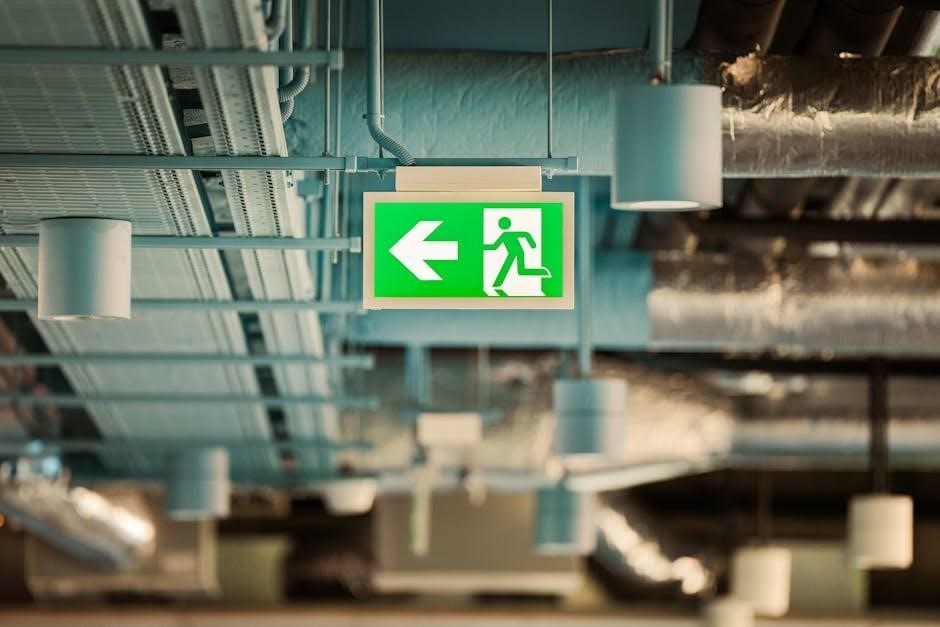Emergency lighting systems are critical for safety, providing illumination during power outages. Functionality is key to ensuring visibility and guidance in emergencies. This guide offers practical steps to identify and resolve common issues, ensuring reliable performance when needed most.
1.1 Importance of Functional Emergency Lighting
Functional emergency lighting is crucial for ensuring safety and visibility during power outages or emergencies. These systems provide reliable illumination, guiding individuals to exits and preventing accidents in dark or smoky environments. Non-operational emergency lights can lead to panic, injuries, and legal liabilities, making their maintenance essential. Regular inspections and troubleshooting are vital to uphold safety standards and compliance with regulations. Emergency lights are often the only reliable source of light during critical situations, emphasizing their importance in safeguarding lives and property. A malfunctioning system can compromise evacuation processes, highlighting the need for prompt identification and resolution of issues. By ensuring emergency lighting works flawlessly, you protect occupants and maintain a safe environment during emergencies.

Common Issues in Emergency Lighting Systems
Emergency lighting systems often face issues like flickering, complete blackouts, or failure to activate automatically. These problems can stem from wiring faults, battery failures, or driver malfunctions, compromising safety and reliability.
2.1 Flickering or Dimming Emergency Lights
Flickering or dimming emergency lights indicate potential issues with the system’s power supply, LED driver, or battery. Faulty connections or loose wires can disrupt power flow, causing inconsistent lighting. Additionally, a failing battery or aged LED driver may struggled to maintain consistent output. In some cases, overheating or dust buildup on light covers can reduce brightness. It’s crucial to address these problems promptly, as unreliable lighting can compromise safety during emergencies. Always test the system after repairs to ensure proper functionality and brightness levels. Regular inspections can help prevent such issues from arising unexpectedly.
2.2 Complete Blackout of Emergency Lights
A complete blackout of emergency lights indicates a severe issue, such as a failed power supply or total battery failure. This could also result from damaged wiring or tripped circuit breakers. In some cases, the LED driver or lighting module may have malfunctioned. To diagnose, check the power source and ensure the unit is properly connected. Inspect wiring for signs of damage or corrosion. If the battery is dead, test it or replace it if necessary. A faulty LED driver may need to be replaced entirely. Always ensure the system is turned off before performing repairs to avoid electrical hazards. Addressing a complete blackout is critical, as it renders the emergency lighting system ineffective during power outages or emergencies.
2.3 Emergency Lights Not Turning On Automatically
Emergency lights not turning on automatically can be caused by a faulty sensor, dead battery, or wiring issues. First, check if the sensor is clean and free from obstructions, as dirt or debris can block its functionality. Ensure the battery is fully charged and test it using a multimeter. Inspect the wiring connections to confirm they are secure and not damaged. Additionally, verify that the automatic feature is enabled in the system settings. If the issue persists, the sensor or battery may need replacement. Regular testing of the automatic activation feature is essential to ensure reliability during power outages. Addressing this problem is crucial, as it directly impacts the system’s ability to provide light during emergencies.
2.4 Unusual Noises from Emergency Lighting Units
Unusual noises from emergency lighting units, such as buzzing, humming, or rattling, often indicate underlying issues. These sounds may stem from faulty electrical components like transformers, capacitors, or the LED driver. Loose internal parts, such as wires or the battery, can also cause rattling noises. To diagnose, inspect the power supply and connections for stability. If the noise persists, the LED driver or capacitor may need replacement. Always disconnect power before performing internal inspections to ensure safety. Addressing such issues promptly is essential, as they can lead to system failure. Regular checks can help identify and resolve these problems early, maintaining the reliability of your emergency lighting system.

Troubleshooting Battery-Related Problems
Battery-related issues often cause emergency light malfunctions. Common problems include drained or aging batteries, faulty charging systems, and loose connections. Testing voltage and inspecting terminals can help identify root causes.
3.1 How to Test the Battery in Emergency Lights
To test the battery in emergency lights, start by ensuring the light is turned off and unplugged for safety. Locate the battery, usually inside the unit, and remove any necessary covers. Use a multimeter set to DC voltage to measure the battery’s voltage by touching the probes to the terminals. Compare the reading to the manufacturer’s specifications. Additionally, perform a load test by applying a small resistor or test light to assess voltage stability under load. Check terminals for cleanliness and inspect wiring connections for damage or corrosion. If voltage is low or inconsistent, the battery may need replacement. After testing, ensure all components are securely reconnected and test the emergency light functionality to confirm proper operation.
3.2 Signs of a Failing Battery
Identifying a failing battery in emergency lights is crucial for maintaining reliable operation. Common signs include dimming or flickering lights during use, as the battery struggles to provide consistent power. The light may not illuminate at all or turn off prematurely, indicating insufficient charge. A failing battery may also cause unusual noises, such as buzzing or humming, due to internal degradation. Physical signs include swelling, cracks, or leakage from the battery casing. Additionally, if the battery takes longer to charge or fails to hold its charge, it is likely nearing the end of its lifespan. Addressing these issues promptly ensures the emergency lighting system remains functional during power outages or emergencies.
3.3 Replacing the Battery in Emergency Lighting Units
Replacing the battery in emergency lighting units is a straightforward process when done correctly. First, disconnect the power supply and wear protective gear to ensure safety. Locate the battery compartment, which may require removing the light cover or accessing a rear panel. Once accessible, disconnect the old battery from the wiring harness and remove it. Install the new battery, ensuring it matches the specifications of the original. Reconnect the wiring and secure the battery in place. Replace any covers or panels and test the unit by triggering a manual test. Proper disposal of the old battery is essential, following local regulations. Regular replacement prevents system failures and ensures reliable emergency lighting performance.
3.4 Checking the Charging System
Checking the charging system is crucial to ensure the battery is being charged correctly. Start by turning off the power supply and verifying the charger’s LED indicators. A green light typically signifies normal operation, while a red or flashing light may indicate a fault. Use a multimeter to measure the output voltage of the charging circuit, comparing it to the manufacturer’s specifications. If the voltage is too low or too high, the charger may need replacement. Consult the user manual for specific voltage ranges and testing procedures. Faulty charging systems can prevent the battery from holding a full charge, leading to emergency light failures. Regular inspections help identify issues early, ensuring reliable performance during power outages.

Identifying and Fixing Wiring Issues
Wiring issues are a common cause of emergency light malfunctions. Inspecting connections, repairing damaged wires, and ensuring secure fittings are essential steps to ensure reliability and safety.
4.1 Inspecting Wiring Connections
Inspecting wiring connections is a critical step in diagnosing emergency light issues. Begin by turning off the power supply to the system for safety. Visually examine all wiring for signs of damage, such as fraying, cuts, or burn marks. Check connections to ensure they are secure and not loose. Use a multimeter to test for continuity and verify that wires are properly connected to the correct terminals. Look for corrosion or dirt buildup, which can disrupt electrical flow. If any issues are found, mark the affected areas for further investigation. Always refer to the system’s wiring diagram to confirm connections are correct. This step helps identify potential faults before moving on to more complex troubleshooting procedures.

4.2 Repairing or Replacing Damaged Wires
When repairing or replacing damaged wires in emergency lighting systems, it’s essential to address the issue promptly to restore functionality. First, identify the extent of the damage by visually inspecting the wires. If the damage is minor, such as a small fray, you can repair it using electrical tape or heat shrink tubing. For more extensive damage, like exposed conductors or multiple breaks, the wire must be replaced entirely. Use appropriate tools like pliers and wire cutters to strip and reconnect the wires securely. Ensure the replacement wire matches the original in gauge and type. After repairs, test the wiring for continuity using a multimeter to confirm proper connections. Always wear insulated gloves and safety goggles when handling electrical components to prevent accidents. Properly sealed and insulated repairs are crucial for long-term reliability.
4.3 Checking for Loose Connections
Loose connections are a common issue in emergency lighting systems, often causing intermittent malfunctions. To identify loose connections, inspect all wire terminals, plugs, and sockets. Look for signs of wear, corrosion, or improper wiring. Use a multimeter to test for continuity and ensure all connections are secure. Turn off the power supply before handling electrical components. Gently wiggle wires to detect any looseness. If a connection feels unstable, tighten it using a screwdriver or appropriate tool. Corroded terminals should be cleaned or replaced. After tightening, test the emergency light to confirm proper functionality. Regularly checking connections helps prevent unexpected failures and ensures reliable operation during emergencies. Always follow safety guidelines when working with electrical systems to avoid accidents.

Diagnosing Problems with the LED Driver or Power Supply
Identify faults in the LED driver or power supply by checking for inconsistent lighting, dimming, or complete shutdowns. Test voltage outputs and inspect for damage or overheating issues.
5.1 Identifying Faults in the LED Driver
Identifying faults in the LED driver involves observing symptoms like flickering or dimming lights, which may indicate unstable power regulation. Consistent issues across all LEDs suggest a driver problem, while isolated issues could point to other components. Testing the power output with a multimeter can confirm if the driver is supplying the correct voltage. A complete shutdown of the emergency lights might indicate a malfunctioning driver, potentially due to damage or failure. Unusual noises, like humming or buzzing, could signal electrical issues within the driver. Additionally, the age and environmental conditions of the system should be considered, as these can affect the driver’s performance. Regular inspections and preventive maintenance are crucial to ensure reliability and safety.
5.2 Replacing the LED Driver
Replacing the LED driver is essential when it fails to regulate power properly, causing issues like flickering or dimming lights. To replace the driver, first disconnect the power supply to ensure safety. Carefully remove the emergency light housing to access the driver, usually located near the LED module. Disconnect the wiring connections attached to the faulty driver, taking note of the terminals for correct reinstallation. Install the new driver, ensuring compatibility with the system’s voltage and current requirements. Reconnect the wiring and reassemble the housing. Test the emergency light to confirm proper functionality. Always use a driver compatible with the specific LED module to avoid further issues. Follow safety guidelines when handling electrical components to prevent accidents or system damage.
5.3 Checking the Power Supply Unit
Checking the power supply unit (PSU) is crucial to ensure it provides the correct voltage and current to the emergency lighting system. Start by disconnecting the power supply and allowing the unit to cool. Use a multimeter to measure the output voltage, comparing it to the manufacturer’s specifications. Look for signs of physical damage, such as burn marks or swelling, which indicate a faulty PSU. If the voltage is inconsistent or the unit is damaged, replace it immediately. Always refer to the user manual for specific instructions, as different models may have varying requirements. A malfunctioning PSU can cause system-wide issues, so addressing it promptly is essential for reliable emergency lighting functionality. Ensure the replacement PSU matches the system’s voltage and power needs for optimal performance.

Bulb and Lamp-Related Troubleshooting
Identify issues like flickering, dimming, or complete bulb failure. Regularly clean lamp covers to ensure optimal light output. Replace faulty bulbs with compatible, energy-efficient alternatives promptly.
6.1 Replacing Failing Bulbs
Replacing failing bulbs is essential to maintain the reliability of emergency lighting systems. Start by switching off the power supply to the unit. Remove the light cover, usually by twisting or sliding it off, depending on the design. Gently pull out the faulty bulb from its socket. Inspect the socket for any debris or damage before installing the new bulb. Ensure the replacement bulb matches the wattage and type specified by the manufacturer. Secure the new bulb firmly in place and reinstall the cover. Turn the power back on and test the light to confirm it’s working properly. Always use gloves to handle bulbs to prevent oil and moisture transfer, which can reduce their lifespan. Regular replacement prevents sudden failures during emergencies.
6.2 Cleaning the Light Covers
Cleaning the light covers is a crucial step in maintaining emergency lighting efficiency. Dust, dirt, and grime can accumulate on the covers, reducing light output and visibility. Start by turning off the power supply to the unit. Remove the light cover, typically by twisting or sliding it off. Use a soft, dry cloth to wipe away loose particles. For stubborn stains, dampen the cloth with mild soap and water, but avoid harsh chemicals or abrasive materials that could scratch the surface. Rinse thoroughly with a clean, damp cloth and dry completely to prevent water spots. Reattach the cover and test the light to ensure proper function. Regular cleaning every 6–12 months helps maintain optimal performance and reliability during emergencies.
6.3 Choosing the Right Replacement Bulbs
Choosing the right replacement bulbs for emergency lighting is essential to ensure reliability and performance. Always consult the manufacturer’s specifications to select bulbs that match the unit’s voltage, wattage, and size requirements. LED bulbs are a popular choice due to their energy efficiency and long lifespan. However, ensure they are compatible with the system’s driver or power supply. Consider the color temperature and lumen output to maintain adequate lighting levels. Check for certifications like UL (Underwriters Laboratories) to ensure compliance with safety standards. Additionally, verify the bulb’s operating conditions, such as temperature range, to suit the environment. Proper bulb selection not only enhances performance but also extends the lifespan of the emergency lighting system. Always purchase from reputable suppliers to guarantee quality and reliability.

Testing the Emergency Light System
Regularly test emergency lights by simulating power outages and ensuring they activate correctly. Use manual and automated tests, verify functionality, and maintain test records for compliance.
7;1 How to Test the Emergency Light Functionality
Testing emergency light functionality ensures the system works during power outages. Start by disconnecting the main power supply to activate the backup battery. Use the test button on the unit to simulate a power failure. Observe if the light illuminates fully and remains steady. For automated systems, check the test results on the control panel. Verify that all emergency lights activate simultaneously and maintain brightness for the required duration. If any light fails to turn on or dimming occurs, inspect wiring connections and battery health. After testing, restore the power supply and document the results for maintenance records. Regular testing ensures compliance with safety standards and guarantees reliable performance in emergencies.
7.2 Understanding Test Results
After testing, analyze the results to determine the functionality of your emergency lighting system. If all lights activate and remain bright for the required duration, the system is functioning correctly. Dimming or flickering indicates issues like battery degradation or wiring problems. Partial activation suggests faulty sensors or wiring connections. A complete blackout points to severe faults, such as a dead battery or power supply failure. Review the test outcomes to identify patterns or recurring issues. Use this data to prioritize repairs and ensure compliance with safety regulations. Document the findings for future reference and to track maintenance progress. Understanding test results helps address problems promptly, ensuring reliable emergency lighting performance during power outages.

Regular Maintenance Tips
Ensure emergency lights function reliably by scheduling regular inspections, cleaning fixtures, checking battery health, and testing functionality monthly. Replace worn components promptly and keep maintenance records;
8.1 Scheduling Regular Inspections
Regular inspections are crucial to ensure emergency lighting systems function correctly. Schedule monthly tests to check functionality, battery health, and wiring integrity. Perform visual checks for dust, damage, or worn components. Test the lights in both normal and emergency modes to confirm proper operation; Use a checklist to track inspections and note any issues. Annual inspections should include deeper checks, such as battery capacity tests and LED driver performance. Consistency in scheduling ensures compliance with safety standards and prevents system failures during emergencies. Always document findings and address issues promptly to maintain reliability.
8.2 Keeping Records of Maintenance
Maintaining detailed records of emergency light system maintenance is essential for compliance and system reliability. Document every inspection, test, and repair, including dates, findings, and actions taken. Record battery replacements, bulb changes, and wiring repairs. Note any recurring issues for future reference. Keep a log of test results and certifications to ensure compliance with safety standards. Digital tools or maintenance logs can help organize this data. Regularly review records to identify patterns and plan preventive maintenance. Accurate documentation also aids in audits and ensures accountability. Store records securely, both physically and digitally, for easy access. Proper record-keeping supports a proactive approach to system upkeep and ensures safety during emergencies.

Tools and Equipment Needed for Troubleshooting
Essential tools include a multimeter, voltage tester, screwdrivers, wrenches, and replacement parts. Safety gear like gloves and goggles is crucial. Specialized tools may include battery testers and LED testers.
9.1 Essential Tools for Emergency Light Maintenance
The essential tools for maintaining emergency lighting include a multimeter for voltage and current testing, a screwdriver set for accessing components, and a voltage tester to ensure safe working conditions. A wrench or pliers may be needed for battery terminals, while replacement parts like bulbs, batteries, and fuses should be on hand. Safety gear such as insulated gloves and goggles is critical when handling electrical systems. Additionally, a torch can help inspect dimly lit areas, and a ladder may be required for high-mounted units. Specialized tools like a battery tester or LED driver tester can diagnose specific issues. Having these tools organized ensures efficient troubleshooting and minimizes downtime for emergency lighting systems.
9.2 Safety Gear for Working with Electrical Systems
When working with electrical systems, proper safety gear is essential to prevent injuries. Insulated gloves and safety glasses protect against electrical shocks and flying debris. A voltage tester ensures circuits are de-energized before work begins. Non-contact voltage testers are ideal for quick checks without touching wires. Arc flash protection, including a face shield and fire-resistant clothing, is crucial for high-voltage tasks. Steel-toe boots and a hard hat provide overall protection in hazardous environments. A fire extinguisher should always be nearby, and a first aid kit is a must for emergencies. Regularly inspect all safety gear for damage and ensure it meets safety standards. Proper use of this equipment minimizes risks and ensures safe troubleshooting of emergency lighting systems.
